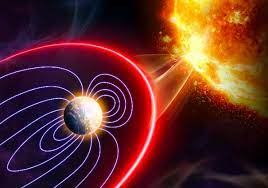Solar Flare : Impact

A powerful solar flare disrupted radio and navigation signals across North America recently.
- A solar flare is an intense burst of radiation coming from the release of magnetic energy associated with sunspots.
- Flares are our solar system’s largest explosive events.
- They are seen as bright areas on the sun, and they can last from minutes to hours.
- In a matter of just a few minutes, they heat the material to many millions of degrees and produce a burst of radiation across the electromagnetic spectrum, including from radio waves to x-rays and gamma rays.
- Although solar flares can be visible in white light, they are often more readily noticed via their bright X-ray and ultraviolet emissions.
- The intense radiation emitted during a solar flare can affect satellite communications, disrupt radio signals, and even pose a risk to astronauts in space.
- The increased solar radiation can lead to geomagnetic storms, which may impact power grids and cause auroras (northern and southern lights) at lower latitudes.
- Geomagnetic Storm is a major disturbance of Earth’s magnetosphere.
- These storms result from variations in the solar wind that produces significant changes in the currents, plasmas, and fields in Earth’s magnetosphere.




